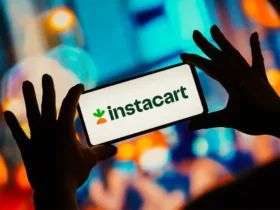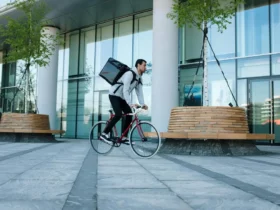In the bustling gig economy, Uber Eats and Instacart stand out as two of the most popular delivery platforms. But when it comes to picking the right gig for you, the decision may not be as clear cut. Your choice largely depends on your vehicle type, the kind of deliveries you enjoy, and your earning expectations.
Uber Eats, with its impressive 60 million monthly active users, offers more vehicle flexibility and a slightly easier gig. It’s a popular choice for food and everyday essential deliveries. On the other hand, Instacart, with a substantial user base of about 10 million, is perfect if you have a car and enjoy grocery shopping. The potential to get large tips with Instacart is also much higher.
Both platforms offer flexibility, making them ideal for those seeking part-time, temporary, or flexible work. You can earn more by receiving tips from customers and even work longer hours if you need extra cash. However, it’s worth noting that while Instacart tips are generally better, you can complete more Uber Eats deliveries per hour, potentially leading to more frequent tips.
Overview of Uber Eats and Instacart
In today’s fast-paced world, delivery platforms like Uber Eats and Instacart are lifesavers that help us meet our daily needs.
These platforms have significantly reduced the need for physical shopping trips. While both are excellent and quick service providers, they serve different purposes and have unique advantages.
Business Models and Core Services
Uber Eats and Instacart are both online-based service providers, but their core services couldn’t be more different.
Uber Eats is primarily a food delivery app, providing smooth and efficient service to its customers.
On the other hand, Instacart is a grocery delivery app. Although they have different delivery items, their services are often compared.
Uber Eats edges out Instacart in most ratings, whether it’s from customers or employees. This is due to its organized and straightforward approach, which ensures proper and timely payments to employees, enhancing productivity.
Instacart, despite being an excellent service provider, has a significant drawback. Often, their delivery personnel can’t find every item on a customer’s grocery list. This results in incomplete deliveries, which can affect customer satisfaction.
Geographic Presence and Market Share
Uber Eats and Instacart both have a considerable presence in the market, but their geographic reach varies. Instacart offers its grocery delivery and pick-up service in the United States and Canada.
Uber Eats, as a global platform, has a broader reach. To make its service more rewarding, Uber Eats provides a subscription plan called Eats Pass. With this, customers get free delivery on all orders and an additional five percent off orders exceeding $15. This can lead to significant savings for regular users.
But if you only use the service occasionally, it may not be worth it.
In terms of customer satisfaction, Uber Eats is the clear winner. But remember, the choice between Uber Eats and Instacart ultimately depends on your specific needs and preferences.
Whether you need a quick meal delivered or your weekly groceries, both platforms have you covered.
Earning Potential: Uber Eats vs. Instacart
In this section, we’ll tackle the topic of earnings potential when working for Uber Eats and Instacart.
Here we’ll discuss the average income, the factors that influence earnings, as well as the tips, bonuses, and incentives offered by the two platforms.
Average Earnings for Drivers and Shoppers
To start, let’s look at the average earnings for Uber Eats drivers and Instacart shoppers. Uber Eats drivers make an average of $8 to $12 per hour after deducting vehicle expenses. Instacart shoppers, on the other hand, can earn between $10 and $20 per hour, depending on the order size and the number of orders they can fulfill. While these figures provide a general idea of what you might earn, there’s potential for significantly higher earnings with a strategic approach. For instance, some Instacart shoppers have found ways to maximize their earnings, reaching up to $500 per week. This level of income requires understanding the nuances of the platform and developing effective strategies for choosing orders and managing time.
If you’re interested in learning more about how to achieve this, check out this detailed guide on how to make $500 a week with Instacart, which offers insights and tips from experienced shoppers.
Factors Influencing Income
Several factors can influence your potential income on these platforms. The time of day, the day of the week, and the area in which you’re delivering can significantly impact your earnings. For example, during peak meal times and on weekends, you’re likely to make more deliveries, leading to higher earnings.
Tips, Bonuses, and Incentives
Finally, we have to consider the tips, bonuses, and incentives offered by both platforms. Uber Eats has a tipping system where customers can tip you directly through the app.
On top of that, Uber Eats offers bonuses for completing a certain number of deliveries within a specified time frame.
Instacart has larger tips due to the nature of the shopping and delivery process. The platform also provides bonuses for shopping during peak hours and incentives for delivering from certain stores.
In both cases, these additional earnings can significantly boost your income, making each platform an attractive option for gig workers.
Again, remember that the choice between Uber Eats and Instacart depends on your preferences, vehicle type, and earning expectations.
Flexibility and Work Schedules
One of the biggest advantages of the gig economy is the flexibility it offers.
With Uber Eats and Instacart, you can set your own schedule and work when it’s most convenient for you.
This makes it an attractive option for people who need to juggle other responsibilities or who simply enjoy a non-traditional work schedule.
Setting Your Own Hours
With both Uber Eats and Instacart, you’re your own boss. You can log in and start working whenever you want and log off when you’re done. This means that you can work as much or as little as you’d like. Best times for Instacart and Uber Eats also differ, so you may want to choose the platform according to the peak times that work for you.
If you’re a night owl, you can make deliveries in the late evening. If you’re an early bird, you can start your day with a few deliveries before everyone else is awake.
It’s entirely up to you.
Peak Times and Demand Patterns
However, it’s important to note that there are peak times when demand is high. These are usually during meal times for Uber Eats and on weekends for Instacart. During these times, you’ll likely have more deliveries and therefore more opportunities to earn money.
Moreover, demand can also vary depending on the location.
In urban areas, there’s usually a higher demand for deliveries compared to suburban or rural areas. This means that you might have more opportunities to make money if you’re willing to work in these areas.
The beauty of these platforms is that they offer real-time information about demand patterns. This allows you to plan your work schedule around these peak times to maximize your earning potential.
While there’s no fixed rule on when to work, being strategic about your work hours can definitely help you earn more. It’s all about finding the balance between flexibility and maximizing your earnings.
Remember, the gig economy is all about flexibility. With Uber Eats and Instacart, you’re free to work on your own terms. Whether you prefer to work early in the morning, late at night, or only on weekends, the choice is entirely yours.
5. Nature of Work and Customer Interaction
The nature of work varies significantly between Uber Eats and Instacart. The two platforms offer different experiences, both in terms of the tasks required and the level of customer interaction. With Instacart, you’re more than a delivery person – you’re a personal shopper. On Uber Eats, you’re primarily delivering food from restaurants to customers’ doors.
The Shopping Experience on Instacart
Working with Instacart involves more than just delivery. Shopping is a key component of the job. As an Instacart shopper, you’ll spend a significant amount of time in grocery stores, carefully selecting and purchasing items for customers. This can be a benefit if you enjoy shopping and are familiar with grocery store layouts.
Customer interaction is also more intensive on Instacart. You’re often in direct contact with customers via the app, communicating about product availability, substitutions, and other details. It’s a role that requires strong customer service skills and attention to detail.
The Delivery Experience on Uber Eats
On the other hand, Uber Eats is primarily about delivery. As an Uber Eats driver, your main task is to pick up food orders from restaurants and deliver them to customers. The job involves less direct customer interaction, as orders are generally ready for pickup when you arrive at the restaurant.
With Uber Eats, it’s all about speed and efficiency. You’ll need to navigate your city quickly, often during busy meal times. Time management is crucial to maximize your earnings. There’s less emphasis on shopping and more on logistics and delivery.
To sum up, the nature of work on Instacart and Uber Eats is quite different. Whether you prefer shopping and more customer interaction or fast-paced delivery work will likely influence which platform is the best fit for you.
However, both offer the flexibility to work on your own terms, which is a major advantage for many workers in the gig economy.
Challenges and Common Issues
Working with Uber Eats and Instacart is not without its challenges.
From customer complaints to app glitches, these common issues can sometimes make the job harder than it needs to be.
But don’t worry! I’m here to tell you how to navigate these situations and maintain a positive work experience.
Dealing with Customer Complaints
It’s a given that you’ll encounter customer complaints in any service industry.
With Uber Eats and Instacart, complaints can range from late deliveries to incorrect orders.
- The key is to remain calm and professional. Misunderstandings and mistakes happen, and it’s essential to handle these situations with grace.
- Communication is also vital. If you’re running late due to traffic or an order mix-up, inform the customer as soon as possible. They’ll appreciate your honesty and transparency.
- Most importantly, learn from each complaint. Use it as a chance to improve your service for the next customer.
Remember, a bad day doesn’t define your overall performance. It’s how you handle these challenges that truly matter.
Navigating App Glitches and Technical Issues
Another common challenge is dealing with technical issues. Both Uber Eats and Instacart apps are not immune to glitches or bugs, which can be frustrating when you’re trying to work.
- Should you encounter an app glitch, try the basic troubleshooting steps first: restart the app, check for updates, or even reinstall it.
- If the issue persists, contact the support team. They’re there to help you resolve any technical issues.
- Keep in mind that patience goes a long way. It can be irritating when the app isn’t cooperating, but getting frustrated won’t solve the problem.
Remember, technology isn’t perfect. Issues are bound to happen, and it’s all about how you handle them that counts.
Challenges are part of the job. Whether it’s dealing with customer complaints or navigating app glitches, it’s all about staying calm, communicating effectively, and learning from each experience.
Benefits and Perks
Working for Uber Eats and Instacart isn’t just about the flexible work schedules and the potential to earn extra cash. They offer a range of benefits and perks that make the job even more appealing. Let’s dig into some of those benefits.
Insurance and Safety Measures
One of the major benefits of working for these platforms is the insurance coverage they provide. Uber Eats and Instacart both offer some form of insurance for their drivers. While the specifics can vary based on location and individual circumstances, this insurance can cover accidents or incidents that occur while you’re on an active delivery.
For example, Uber Eats provides insurance protection for its drivers, covering up to $1 million in liability if something goes wrong while you’re delivering an order. Similar coverage is offered by Instacart, helping to ensure you’re protected while you’re out on the job.
Another significant benefit is the focus on safety measures. Both platforms have implemented features designed to protect drivers. Uber Eats has included safety features in their app, such as GPS tracking and 24/7 support. Instacart focuses on ensuring their shoppers’ safety in the stores and has protocols in place in case shoppers feel uncomfortable or unsafe.
Partnerships and Discounts for Workers
Uber Eats and Instacart also offer perks in the form of partnerships and discounts, which can add up to significant savings. For instance, Uber Eats has partnerships with certain auto maintenance and cell phone companies, providing discounts that can help you save money on expenses related to your work.
Instacart, on the other hand, has an advantage program that provides resources and discounts to their shoppers. These can include discounted rates on health insurance, tax and legal services, and even car rentals. With these partnerships and discounts, you can lower your costs and increase your overall earnings.
As you can see, working for Uber Eats and Instacart offers more than just flexible work schedules and the chance to earn extra cash. They offer a range of benefits and perks that can make your work experience more rewarding and worthwhile. Whether it’s insurance coverage, safety measures, or discounts from partnerships, there’s a lot to appreciate about these platforms.
What Do Other Drivers Say?
When it comes to understanding the real-world implications of working for Uber Eats and Instacart, there’s no better source than the drivers themselves. I’ve gathered some insights from various online forums, social media platforms, and direct interviews to provide a comprehensive overview of what it’s actually like to work for these platforms.
Positive Aspects of Each Platform
Drivers often highlight the flexibility that both Uber Eats and Instacart offer. They appreciate the ability to work whenever they want, which is particularly beneficial for those seeking a side gig or balancing other commitments. The potential to earn a substantial income, especially during peak hours and in busy areas, is another positive aspect frequently mentioned.
Uber Eats drivers, in particular, value the company’s insurance policy, which provides up to $1 million in liability coverage. They also appreciate the 24/7 support and safety measures in place, such as GPS tracking. The partnerships and discounts offered by Uber Eats, which can help drivers save on work-related expenses, are another plus.
Instacart drivers, on the other hand, express satisfaction with the company’s shopper safety protocols in stores. They also appreciate the discounted rates offered on health insurance, tax and legal services, and car rentals.
Areas for Improvement
While there are many benefits to working for Uber Eats and Instacart, drivers also identify areas for improvement.
For Uber Eats, drivers often cite inconsistent earnings and the wear and tear on their vehicles as drawbacks. They also suggest the platform could do more to address customer complaints and queries promptly and effectively.
Instacart drivers, meanwhile, express concerns about the app’s functionality, stating that it can sometimes be glitchy and difficult to navigate. They also mention the physical demands of the job, as it can involve heavy lifting and long periods of standing. Lastly, they suggest the platform could offer more competitive pay, especially when considering the physical demands and vehicle expenses associated with the job.
Overall, the experiences of drivers highlight the benefits and challenges of working for Uber Eats and Instacart. These insights can help prospective drivers make informed decisions about whether these platforms might be a good fit for them.
Conclusion: Which One is Right for You?
Deciding between Uber Eats and Instacart is a personal choice. It’s about weighing the pros and cons of each platform. Both offer flexible scheduling, insurance coverage, and partnerships for driver benefits.
Yet, they also have their unique strengths.
Uber Eats stands out with its robust insurance and safety measures, while Instacart shines with its shopper safety protocols and discounted rates on services.
However, they’re not without their drawbacks. Concerns about inconsistent earnings and vehicle wear and tear are common with Uber Eats. Instacart drivers, on the other hand, express worries about app functionality and competitive pay.
Ultimately, it’s about what matters most to you. If safety and insurance coverage are your priorities, you might lean towards Uber Eats. If you value in-store safety and service discounts, Instacart could be your go-to.
Remember, it’s about finding the right fit for your lifestyle and needs. So, take the time to consider your options carefully before making a decision. After all, it’s not just about earning extra cash, but also about enjoying the work you do.













